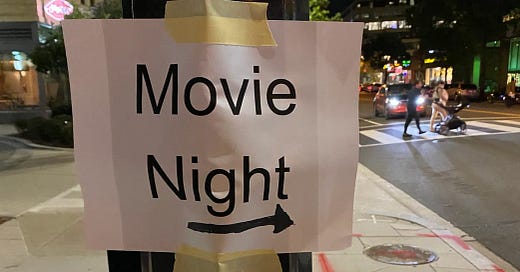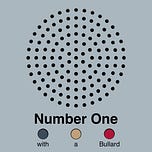The audio of this edition is an interview I recorded with the hosts of the podcast Hit Factory (Apple podcasts; Spotify; Patreon). I’m using the text here to elaborate about what was on my mind when I decided to reach out for the interview, and to reflect on some of what we talked about. Also, this essay by Aaron Thorpe comes up in the interview. I’m hoping to add more interviews to my rotation. This is the second I’ve done. The first was with filmmaker Jeff Krulik.
I’ve been on this self-imposed nostalgia beat for a while now, and I keep grappling with the same question.
If nostalgia tends to rise from our unhappiness with the present, and if it’s most often expressed as a romanticization of the past, how do we separate this from an understanding that parts of the past were, generally, better? Nostalgia is a fine reason to like something, and all taste is subjective, but nostalgia is a personal emotion. I wonder how we can talk about art and culture and history in ways that are more shareable, more universal.
A person or a culture in the throes of nostalgia will always see the past as preferable to the current alternative. But the leaden thumb of nostalgia isn’t permanently on the scale. Not everything progresses at the same pace. Sometimes, there’s regression.
I think about this a lot with clothes. Compared to what was in stores a few decades ago, most clothes today are terribly made. In 2020, my dad gave me a bunch of his old sweaters. They’d been worn hundreds of times, but they were in much better condition than a pair of crew necks I’d splurged on at a high-end store the year before. There was no pilling, no split seams on the shoulders, and the wool was thick enough to obscure the pattern on the shirt I wore underneath. These were good sweaters, but they weren’t from the most rugged outfitters or the more exacting boutiques. Most of the vintage clothes I own are from unremarkable or forgotten brands. I have a few jackets with no branding on the labels other than the name of long-closed department stores from mid-sized cities. These are clothes made for middle-class masses. They have endured for decades. Now they tower over mainstream competitors in terms of material quality.
“They don’t make them like this anymore” is the call of the crank, but sometimes it’s true. This gets harder to discern when the material assessment blends with aesthetic assessment.
Whenever I’m watching an older movie (so…most days), Linda teases me for how much I say “this looks so good,” at a particular shot or sequence. There’s just something about the look of a movie shot on real film in a real setting that appeals to me. I’ve written about how this has even affected my memory. Movies shot with digital cameras can look great, too.1 And special effects can do wonders. But these technological advancements also make it easier to produce something that looks bad—or at least something that looks artificial and manipulated after-the-fact to cover sloppiness earlier in the process. The average movie made thirty or so years ago has a basic material quality that stands apart from the average movie made today. It’s hard to not equate this with the overall quality of the movie. Certainly it’s part of the evaluation, but if it were a deciding factor, then I would be stuck in a nostalgic logic loop, insisting that the trump card for quality is one that every old movie has and that most new movies will never possess.
This is what makes my persistent question so frustrating. When I watch an older movie, I have trouble sorting out my feelings about it because I have trouble figuring out how much those feelings are influenced by the fact that certain basic sensory experiences trigger warm feelings in me.
And that’s why I like the podcast Hit Factory. It’s not exclusively or entirely about the questions I’m getting at in this essay, but it is about the movies of the past. In each episode, hosts Aaron Casias and Carlee Gomes talk about a different movie from the 1990s. But Hit Factory is not a nostalgia podcast. Casias jokingly calls it “an anti-nostalgia podcast.”
“I don't mean that broadly, as in we shame you for it and we're above it,” Casias says. “But I think anyone who has come to our show in the past, or who may in the future, thinking that what we're going to be offering is this neon-colored, geometric patterns, bright, fun, bubblegum and soda idea of the ‘90s is going to be left kind of disappointed by our show.”
This doesn’t mean Hit Factory is a takedown show. The ‘90s were “the last time movies, broadly speaking, were good,” Casias says. “There are still great movies being made all the time, but you could approach pretty much any movie in the 1990s, even the most middlingly received, mid-budget kind of thriller or adult drama and find that there was an artistry and a care and a craftsmanship to it that seemed to steadily decline over the course of the next 20, 25 years of movie-dom.”
The reason for this isn’t just that material quality of film stock and lighting. It’s related to the reason why clothes today are so poorly made compared to a few decades ago.
“We were at a different stage in this grind of neoliberal capitalism then,” Gomes says. “That’s not to say that all the movies were good, but the products that were being made, the art that was being made, is fundamentally different than the art that is being made now.”
Movies, in most cases, are a commercial product. So are clothes. And the traits that drive sales have shifted. In my dad’s time, sturdiness and longevity had greater value. People didn’t buy as many clothes and trends changed less frequently. Now that a sweater will be out of fashion a few months after it first goes on sale, longevity is less important than of-the-moment stylishness. Someone may not even notice that their new clothes are poorly stitched from shoddy fabric because they will be forgotten in a drawer long before they’ve been worn enough to deteriorate. When movies are made to advance part of a sequential superhero plot (or are expected to turn a quick profit for investors) then things like aesthetics and artistry are no longer a priority.
“The process of commodification, really extensive commodification over the last 30 years, has changed the landscape of what films are,” Gomes says. “They are, more likely than not, now content, rather than stories. They are signifiers of ideas or ideologies rather than stories and narratives that explore ideologies.”
This is another reason why I like revisiting old movies and following along on Hit Factory. I was a child in the ‘90s. I saw the movies they cover in pieces on cable or on tapes I rented from Mr. Video, the shop down the street from my parents’ house. The movies make me nostalgic through their basic appearance. As an adult, I can understand how these movies existed in the context of their times (Gomes mentions the police politics of Speed in our interview). Rewatching—especially with a guide—adds depth to the personal memories and make sense of the world I grew up in.
And this makes the question of how to talk about the past outside of the context of nostalgia so vexing. The things we lose matter—why we lose them, whether we should lose them, and what follows them are questions we don’t always take time to ask. Fast fashion has been devastating to the workers who make clothes and to our planet. The move toward visual effects-heavy filmmaking has also been a nightmare for workers and is detrimental to a medium that can help us understand the world around us.
People who are outside of production acquiesce to these changes because other options gradually become inaccessible (either by no longer existing or by becoming prohibitively expensive), or because the changes happen gradually enough to be subtle, but no slower than necessary to maximize profits. “Your average American understands that things are increasingly bad, even if they can't name why,” Gomes says.
That feeling leads to nostalgia. And this is why I’m so vexed about how we talk about the past while we’re in the middle of a nostalgia trip. It’s impossible to truly separate nostalgia from our feelings of the past. And that’s good. Our warm memories are comforting and reassuring, and sometimes it’s easy to get caught up in them and surrender to the idea that things will never be the same. But if we examine those feelings and understand why things aren’t the same, why they should or shouldn’t be, then our nostalgia trips can get even more beneficial. We can visit the past and know what we should bring back.
One of my favorite movies of the 2000s, Zodiac, was mostly shot on digital.
















Share this post